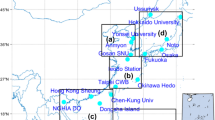Abstract
The use of Local Area Coverage (LAC) data from Ocean Color Monitor (OCM) sensor of Oceansat-2 with its high radiometric resolution (12 bits/pixel) and 2-day repeat cycle for rapid monitoring of vegetation growth and estimating surface albedo for the Indian region is demonstrated in this study. For the vegetation monitoring, normalized difference vegetation index (NDVI) and vegetation fraction (VF) products were estimated by maximum value composite approach fortnightly and were resampled to 1 km. The surface albedo products were realized by converting narrow-band eight-band spectral reflectance OCM data to a) visible (300–700 nm) and b) broad band (300–3,000 nm) data. For validation, the derived products were compared with respective MODIS global products and found to be in good agreement.






Similar content being viewed by others
References
Chavez, P. S., Jr. (1996). Image-based atmospheric corrections: revisited and improved. Photogrammetric Engineering and Remote Sensing, 62, 1025–1036.
Gitelson, A. A., Kaufman, Y. J., Stark, R., & Rundquist, D. (2002). Novel algorithms for remote estimation of vegetation fraction. Remote Sensing of Environment, 80, 76–87.
Gutman, G., & Ignatov, A. (1998). The derivation of the green vegetation fraction for NOAA/AVHRR data for use in numerical weather prediction models. International Journal of Remote Sensing, 19, 1533–1543.
Holben, B. N. (1986). Characteristics of maximum-value composite image from temporal AVHRR data. International Journal of Remote Sensing, 7, 1417–1434.
ISRO. (2010). Oceansat 2 Mission. In 47th Session of STSC-UNCOPUOS, Vienna, February 08–19, 2010. http://www.oosa.unvienna.org/pdf/pres/stsc2010/tech-47.pdf.
Julien, Y., & Sobrino, J. A. (2010). Comparison of cloud-reconstruction methods for time series of composite NDVI data. Remote Sensing of Environment, 114, 618–625.
Keerthi, V. & Kumar A. S. (2010) Computation of at-sensor solar exo-atmospheric irradiance, Rayleigh optical Thickness and Spectral Characteristics of OCM1 and OCM2 sensors. Technical Report: NRSC/DPA/DQEPQCD/SN/-January-2010, 1--6.
Kuznetsov, A. Y., Getkin, Y. M., & Antonushkina, S. V. (2003). Photometric correction of satellite images. Mapping Sciences and Remote Sensing, 40, 147–154.
Liang, S. (2001). Narrowband to broadband conversions of land surface albedo. Remote Sensing Environment, 76, 213–238.
Liang, Z., Bing-fang, W. U., Yue-min Z., Ji-hua M., & Zhang, N. (2008). A study on fast estimation of vegetation fraction in three Gorges emigration area by using SPOT5 imagery. In The International Archives of the Photogrammetry, Remote Sensing and Spatial Information Sciences. Vol. XXXVII. Part B8. 987--992. Beijing 2008. http://www.isprs.org/proceedings/XXXVII/congress/8_pdf/10_WG-VIII-10/12.pdf.
Mishra, V. D., Gusain, H. S., & Arora, M. K. (2012). Algorithm to derive narrow band to broad band albedo for snow using AWIFS and MODIS imagery of western Himalaya – Validation. International Journal of Remote Sensing Applications, 2, 52–62.
Nguyen, T. T. H., de Bie, C. A. J. M., Ali, A., Smaling, E. M. A., & Hoanh, C. T. (2012). Mapping the irrigated rice cropping patterns of the Mekong delta. Vietnam through hypertemporal SPOT NDVI image analysis. International Journal of Remote Sensing, 33, 415–434.
Nigam, R., Bhattacharya, B. K., Gunjal, K. R., Padmanabhan, N., & Patel, N. K. (2012). Formulation of time series vegetation index from Indian geostationary satellite and comparison with global product. Journal of Indian Society of Remote Sensing, 40, 1–9.
NRSC. (2012). Geophysical products: Vegetation Fraction: OCM2 http://bhuvan-noeda.nrsc.gov.in/download/download/download.php.
Oza, S. R., Singh, R. P., & Dadhwal, V. K. (2006). Characterization of vegetation fraction estimated using SPOT Vegetation NDVI data for regional climate modeling India. Mausam, 57, 669–674.
Sandya, K. N., Rajeev, K., & Parameswaran, K. (2004). Cloud screening in IRS-P4 OCM satellite data: potential of spatial coherence method in the absence of thermal channel information. Remote Sensing of Environment, 90, 259–267.
Serban, C., Maftei, C., & Filip, C. (2011). Assessment of Multispectral vegetation indices using remote sensing and grid computing. International Journal of Computers, 5, 468–475.
Song, J., & Gao, W. (1999). An improved method to derive surface albedo from narrowband AVHRR satellite data: Narrawband to broadband conversion. Journal of Applied Meteorology, 38, 239–249.
Tasumi, M., Allen, R. G., & Trezza, R. (2008). At-surface reflectance and albedo from Satellite for operational calculation of land surface energy balance. Journal of Hydrologic Engineering, 13, 51–63.
Vermote, E., Tanre, D., Deuze, J. L., Herman, M., & Morcrette, J. J. (1997). Second simulation of the satellite signal in the solar spectrum, 6S: an overview. IEEE Trans Geoscience and Remote Sensing, 35(3), 675–686.
Vermote, E., Justice, C., Descloitres, J., El Saleous, N., Roy, D. P., Ray, J., Margerin, B., & Gonzalez, L. (2001). A SeaWiFS global monthly coarse-resolution reflectance dataset. International Journal of Remote Sensing, 22(6), 1151–1158.
Wardlow, B. D., & Egbert, S. L. (2008). Large area crop mapping using time series MODIS 250 m NDVI data: an assessment for the U.S. Central Grain Plains. Remote Sensing of Environment, 112, 1096–1116.
Zhao, W., Tamura, M., & Takahashi, H. (2001). Atmospheric and Spectral Correction for estimating surface albedo from satellite data using 6S code. Remote Sensing of Environment, 76, 202–212.
Acknowledgments
Technical discussions held with K. Chandrasekar, Agricultural Sciences Applications Group, NRSC are sincerely acknowledged. Support provided by K.V. Chandrasekar, Operational Director for Oceansat-2 data products for timely supply of OCM products is acknowledged with thanks. Authors sincerely thank anonymous reviewers whose comments have helped to improve significantly the content of this paper.
Author information
Authors and Affiliations
Corresponding author
About this article
Cite this article
Kumar, A.S., Radhika, T., Saritha, P. et al. Generation of Vegetation Fraction and Surface Albedo Products Over India from Ocean Colour Monitor (OCM) Data Onboard Oceansat-2. J Indian Soc Remote Sens 42, 701–709 (2014). https://doi.org/10.1007/s12524-014-0371-y
Received:
Accepted:
Published:
Issue Date:
DOI: https://doi.org/10.1007/s12524-014-0371-y




